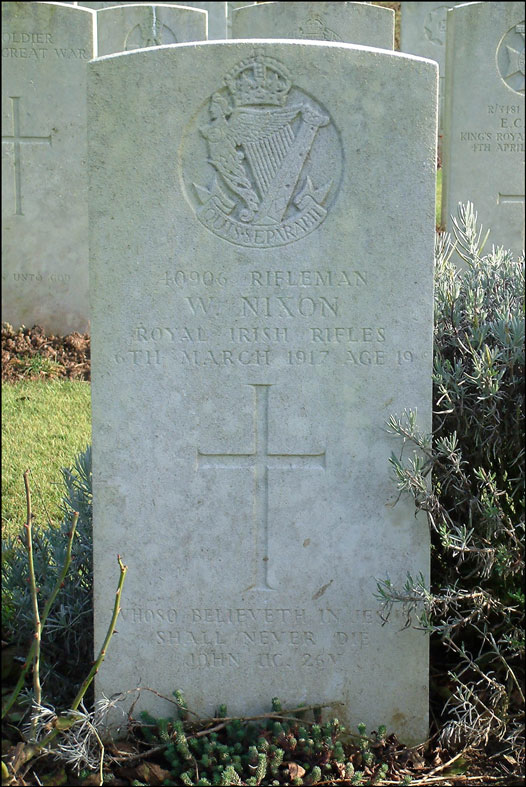![]() In memoriam
In memoriam ![]()
Rifleman William Nixon
William Nixon was born at Derryinch, Bellanaleck, County Fermanagh, on 26 March 1897, son of farmer John Nixon and his wife Emily (nee Veitch). His father died when William was just 7 years old, leaving his widow, and his sons William and Samuel, and a number of younger daughters, to run the farm.
Nixon enlisted in the North Irish Horse at Antrim at the end of January 1916 (No.2094).
In November that year Nixon, together with around 100 other North Irish Horsemen, volunteered to transfer to the Royal Irish Rifles (No.40906). They embarked for France on 7 December, where they joined the 1st Battalion, Royal Irish Rifles, on the Somme front.
At the beginning of March the battalion took part in a short but fierce attack in the sector in front of Bouchavesnes, captured by the French the previous September and only recently handed over to the BEF. The attack was a complete success. Within forty minutes the objectives – Pallas Trench and Fritz Trench behind it – were seized. The consolidation took longer, with artillery bombardment and counter-attacks from an enemy not keen to be pushed out. The 1st Battalion, Royal Irish Rifles, initially held in reserve, received orders to come up in relief at 6.00 pm. This from the Battalion’s war diary:
[4 March] Orders were received for the Battalion to march up and relieve 2 Lincolnshire Regiment and supporting companies of the 2 Rifle Brigade, the 2 R Berkshires still maintaining their position in the captured trenches. The Battalion therefore took up a position in the old British front line and support. The shelling during the night was severe. During the afternoon the enemy counter attacked and gained a footing in a part of the trench, 3 OR belonging to our Lewis Gunners but to 2 R Berks were killed.
At midday on 5 March the Battalion was ordered to relieve the 2nd Royal Berkshires in the front line. This they accomplished that night.
The shelling was again heavy. 1 OR was killed 3 OR wounded. D Coy held the new front line, C Coy were in Pallas Trench, A Coy in a new trench leading from Pallas to old British front line, B Coy in old British line.
[6 March] Shelling still severe but consolidation continued.
[7 March] 5 OR killed 19 OR wounded.
[8 March] 11pm. Battalion relieved in the front line by 2 Rifle Brigade, move to a base in Bouchavesne and Lock Barracks.
Records show that 27 men of the 1st Battalion, Royal Irish Rifles, were killed between 4 and 8 March. Among them were four former North Irish Horsemen – Riflemen William Nixon and John Nixon Gibson, and Lance Corporals John McSparron and Thomas Hall.
Nixon was killed in action on 6 March. He was buried near where he fell, in the newly captured German trench system (map reference 62c.C.16.C.9.9), the location marked with a cross. After the war his body was moved to Fins New British Cemetery, Sorel-le-Grand, Somme, France, grave VIII.D.26. His gravestone inscription reads:
40906 RIFLEMAN
W. NIXON
ROYAL IRISH RIFLES
6TH MARCH 1917 AGE 19
WHOSO BELIEVETH IN JESUS
SHALL NEVER DIE
JOHN 11C. 26V
Image kindly provided by Richard Evans. See his website Nelson, Glamorgan and the Great War http://www.nelson-ww1-memorial.org.uk.

